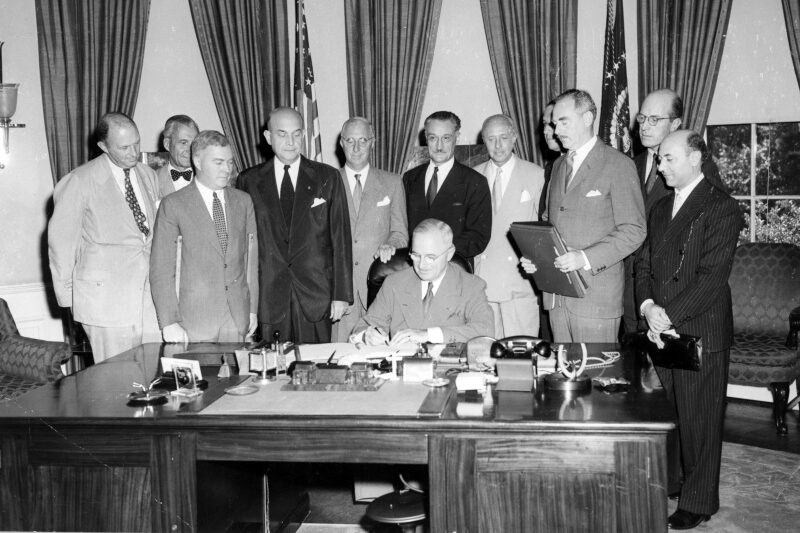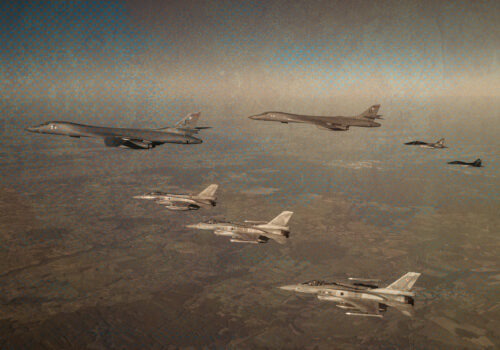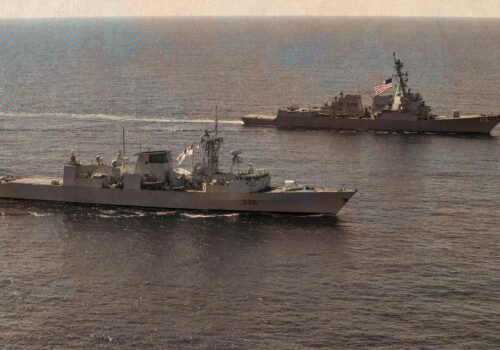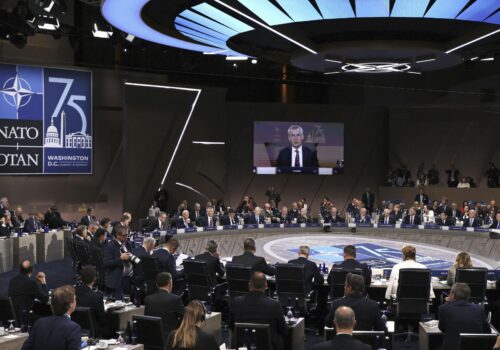August 24 marks seventy-five years since the North Atlantic Treaty entered into force. At the time, US President Harry S. Truman called it a “momentous occasion” that was bringing the Atlantic community closer together.
There were also those then, as now, who question whether the Alliance would endure.
In no small part, this questioning is because much of the discussion confuses the modern-day institution that is NATO, set up in 1949, with the much more profoundly rooted and connected transatlantic bonds that give NATO its essential strength. These bonds stretch far and wide across historical generations, much further back in time than 1949, and they will likely continue to stretch far into the future. And these bonds are rooted deeply through layers of cultural and institutional transatlantic connectedness, which have grown atop one another over time and under many different geopolitical configurations. Far from naturally declining with time, the alliance’s nature is to continue growing.
If not 1949, then when?
Historically, NATO is most accurately defined as the latest stage of this deep-rooted alliance. The commitments set out in the North Atlantic Treaty make 1949 a milestone, not as a creation ex nihilo, but as a punctuation mark in the evolutionary growth of the transatlantic alliance, one that existed well before 1949. It existed in 1941. It existed in 1917. It existed in different forms long before that.
The 1949 start date gives a dangerously incomplete picture of what the alliance is about. It makes it look like something that was meant solely for a single geopolitical configuration, the one against the Soviet Union—an impression that is too often stated as if it were a fact. It is an error. The Atlantic alliance worked well in an opposite geopolitical configuration, in 1917 and 1941—one with Germany as an enemy and Russia as an external ally. The North Atlantic alliance has existed in a still different configuration dating back to when the British settled Jamestown in 1607 and Spain was the defining enemy. Incidentally, Spain and Germany later both joined the Alliance. The “defining enemy” was never really the heart of what defined the alliance.
In each of these configurations, the Atlantic allies from the previous configuration have continued as the core allies of the new one. In this sense, the alliance has been a historical constant, even while greatly changing. That’s the remarkable fact.
Why the start date matters
How leaders, policymakers, and the public view this history has real-world consequences. A focus limited to 1949 can make opposition to Russia loom too large as an instigating and animating force behind the transatlantic alliance. The absence of the larger historical context in people’s minds obstructs an understanding of the alliance as deeply rooted. It also has the potential to restrict support for the alliance to one faction in the West, a faction focused on a single friend-enemy configuration. It leads other factions repeatedly to wonder if NATO is getting old and nearing the end of its shelf life. And it makes it harder to jointly address other problems that face the allies, such as China.
The layers of the alliance
The transatlantic alliance has multiple layers: NATO, the commonalities of the societies, the shared interests and norms, and the strategic co-alignment. These layers have their own start dates, and they have piled one atop another over the centuries. That makes the long Atlantic history a pattern of alliance growth in its depth, alongside its growing geographic reach.
Five layers of Atlanticism
- Transatlantic commonalities: Similar economic and political institutions and cultures since 1607; shared strategic and economic interests
- Massive mutual trade, investment, and family relations
- Strategic co-alignment on the main geopolitical divide at each time
- NATO
- An Atlantic-rooted system of institutions: Indo-Pacific partners, the Organisation for Economic Co-operation and Development, and the Group of Seven (G7), among others
The enduring strategic co-alignment of the North Atlantic societies is a critical layer for its being an alliance at all. It is what defines it as a deep alliance, not just an ephemeral partnership. The co-alignment has never been a perfect one, and it does not cover all issues. But it always exists on the main international strategic divide of the time.
The co-alignment in the North Atlantic started as early as the British colonization of North America in 1607. It was interrupted only once, from 1776 until the 1820s, when two developments brought about its resumption: the Monroe Doctrine, de facto enforced by the British Navy, realigning Britain with the United States; and the break-up of the Holy Alliance into Eastern autocratic and Western liberal halves. Since its resumption, it has continued to this day. The co-alignment on the core strategic issue has continued straight through many changes and reversals in what the core strategic issue has been. This makes it even more than an ordinary strategic alliance. It brings it near to being a strategic fusion: a strategic “invariant.”
Alliance development has occurred in stages of growth: the beginnings of the common transatlantic society in 1607; its almost continuous growth in population and territory ever since; the strategic co-alignment all this time, except for a hiatus for half a century after 1776; the active fighting Atlantic alliances of the world wars; the institutionalization in NATO of the practices developed in those wars; a series of enlargements of NATO; and the emergence of a Pacific wing of the alliance with the Australia, New Zealand and United States Security Treaty, known as ANZUS, as well as the US-Japan and US-South Korea treaties.
Looking backwards to look forward
What looking backwards has shown us is that the transatlantic alliance is deeply embedded in the modern world, and can be expected to remain both as an invariant and as a growing thing, with new members and functions.
Can pessimists at least say the transatlantic alliance will decline vis-à-vis rising powers? Not likely. Writers have been saying this for more than a century, but alliance growth in membership has enabled it always to keep ahead of countries that are trying to catch up with it. It grows in two dimensions—internally, in the economies of its member states, and externally, in the number of member states. Its potential adversaries similarly grow internally, but when they cobble together external alliances, they lack the depth and durability of the Atlantic one. Their alliances have always proven ephemeral; they lack the Atlantic alliance’s deep commonalities. They lack also its congruence with the developmental needs of modernity. Meanwhile, the growth of the Atlantic grouping internationally remains cumulative. Westernization proceeds everywhere, even in countries that resist it. Most of the alliance’s historic enemies have later joined it. Few are the countries that would never want to join. NATO may find it unwise to let some in for a significant time to come, but there is no permanently fixed exclusion line.
It is not wise to prophesy doom for the alliance; that has always proved wrong. Nor to toy with abandoning the visible, NATO layer of the alliance; that only does harm for a time, and then it gets rebuilt anyway. What is wise is to work on further developing the alliance. That is what the framers of NATO believed when they took the initiative to negotiate the treaty seventy-five years ago. History rewarded it.
Ira Straus is a senior advisor at the Atlantic Council’s Scowcroft Center for Strategy and Security and a member of the Atlantic Council’s councilors program.
Further reading
Tue, Jul 30, 2024
To deter Russia, NATO must adapt its nuclear sharing program
New Atlanticist By Michael John Williams
Russian President Vladimir Putin has time and again played the United States and its European allies, believing that they are too scared of the long shadow cast by nuclear weapons to push back against his threats.
Wed, Aug 7, 2024
How NATO and its Indo-Pacific partners can work together in an era of strategic competition
New Atlanticist By Gorana Grgić
Amid rising threats from Russia and China, it is in the interest of both NATO and its Indo-Pacific partners to deepen their cooperation.
Mon, Jul 15, 2024
This might be NATO’s greatest struggle yet—and it’s global
Inflection Points By Frederick Kempe
At its Washington summit, NATO acknowledged how China and Russia are working together to revise the global order. But what will the Alliance do about it?
Image: President Harry S. Truman (seated) signs a proclamation declaring into effect the 12-nation North Atlantic Pact. They are in the Oval Office. Witnessing the signing are, from left to right: Sir Frederic Hoyer-Millar of the United Kingdom; Ambassador Henrik de Kauffmann of Denmark; Canadian Embassy Counselor W. D. Matthews; Secretary of Defense Louis Johnson; Ambassador Wilhelm Munthe de Morgenstierne of Norway; Ambassador Henri Bonnet of France; Baron Robert Silvercruys, Ambassador of Belgium; Ambassador Pedro Pereira of Portugal (partly obscured by Acheson); Secretary of State Dean Acheson; Netherlands Minister Jonkheer Otto Reuchlin; and Italian Embassy Counselor Mario Lucielli. Credit: Abbie Rowe National Park Service Harry S. Truman Library & Museum.



